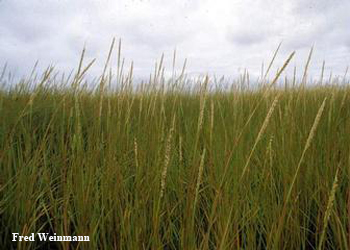Invasive Plants and Agricultural Pest Management
Welcome to Alaska's Invasive Plant Program. Our program coordinates prevention, outreach and management strategies for invasive plant issues through collaboration with land managers, agencies, organizations and policy makers across Alaska. These efforts are guided by the implementation of our Strategic Plan and relevant noxious weed regulations and policies. Our goal is to help keep Alaska's pristine landscapes and natural resources free from impacts of noxious and invasive plants.
PMC Programs
- PMC Home Page
- Horticulture
- Industrial Hemp
- Invasive Plants
- Plant Pathology

5310 S Bodenburg Spur
Palmer, AK 99645
Phone: 907-745-4469
Fax: 907-746-1568
Mon. - Fri.
8 a.m. - 4 p.m.
Click Map For Directions
View Larger Map
Cordgrass Species (Spartina spp.)
AK Natural Heritage Program Invasiveness Ranking: 86
The cordgrasses of the genus Spartinainclude 17 species that are indigenous to North, Central and South America, Europe and North Africa. Four of these species have been introduced to and are invasive species in estuaries on the West Coast of North America: S. alterniflora, S. angelica, S. alterniflora x foliosa, S. densiflora, S. densiflora x foliosa, S. patens.
- Biology
- Impact
- Distribution
- Taking Action
- Resources
- • Perennial grass
- • Stems are stout, upright and densely spaced
- • Forms thick mats of roots and rhizomes
- • Ranges in height from 6 inches to 7 feet; depending on the environment
- • Inflorescence is a congested spike bearing single-flower spikelets
- • Leaves are thick and wide
- • Reproduces by rhizomes, seeds and vegetative fragments

Where it is introduced, cordgrasses fill in mudflat habitats, transforming them into dense meadows. This extensive and invasive replacement of native, wetland vegetation has resulted in the loss of habitat for Tanner and Dungeness crabs, clams and oysters, the spawning of commercially and recreationally important fish, including salmon and halibut, and additional economic losses to those who rely on these species. The spread of cordgrasses in estuaries and channels also poses threats to navigation and flood control. Cordgrasses have the potential to completely change this delicate mudflat ecosystem; coveted by Alaskans not just for its resources, but also for its beauty.
Cordgrasses have not been found in Alaska. However, their introductions from the east coast to the Pacific coastlines of California, Oregon, Washington and British Columbia have resulted in the loss of hundreds of acres of salt marsh habitat. For a better understanding of environments in Alaska most suitable for growth and reproduction of cordgrasses, models have indicated wave-protected areas with wide-sediment flats or estuarine habitats are at most risk.
Habitat: estuarine areas on saline substrates, and open tidal mudflats.
Because cordgrasses are not yet found in Alaska, early detection of small, pioneer infestations of Spartina spp. is critical to an effective control and eradication strategy. Relatively small populations of Spartina spp. are susceptible to a variety of control that is most appropriate for the site and size and stage of the infestation. Cost-effectiveness of physical methods, such as digging, mowing, covering and tilling, vary with the size and the species of cordgrass. Hand-digging is only feasible in areas with seedlings or isolated small clones no wider than 50 cm in diameter; any rhizomes left behind could regrow in place or disperse in a new area. Larger infestations (>1 acre) are likely to require chemical methods for eradication, but the size threshold is likely to be species specific.
Early detection and rapid response are critical to cost-effective management of Spartina spp. Based on successes in Oregon and Willapa Bay in Washington, large and small scale control is possible with adequate resources and should be eradicable in three to ten years.
